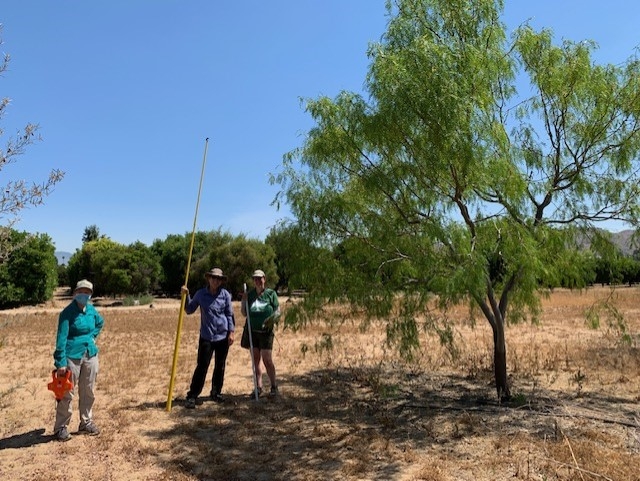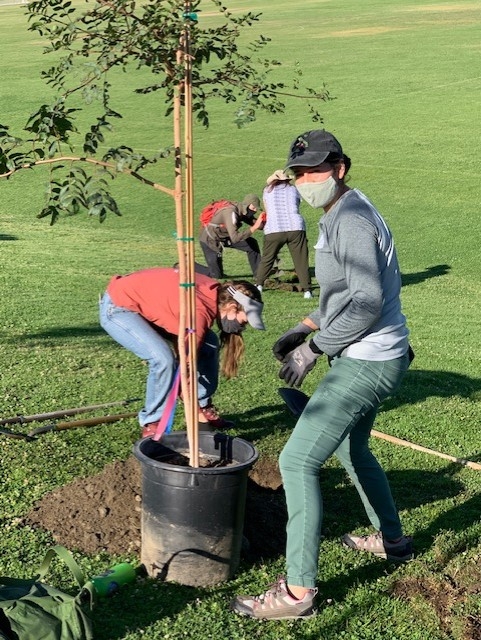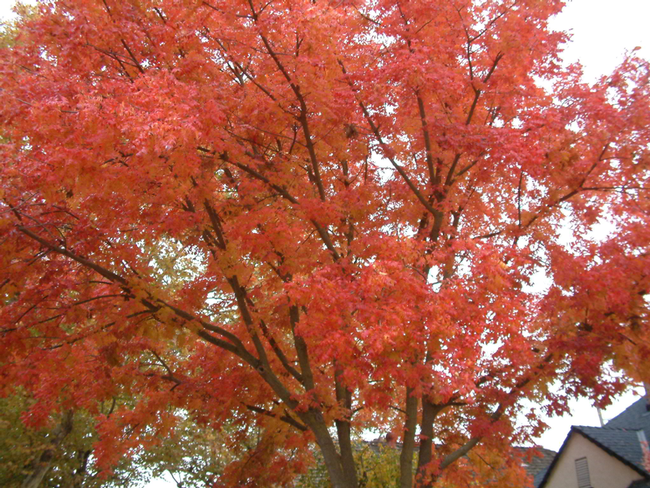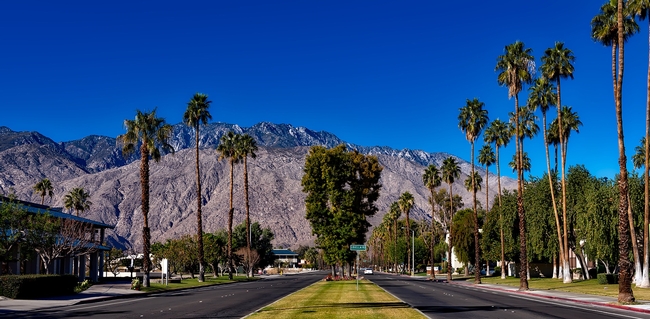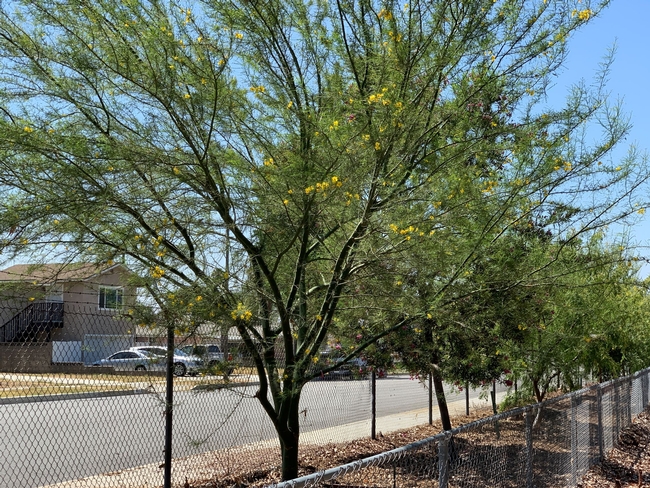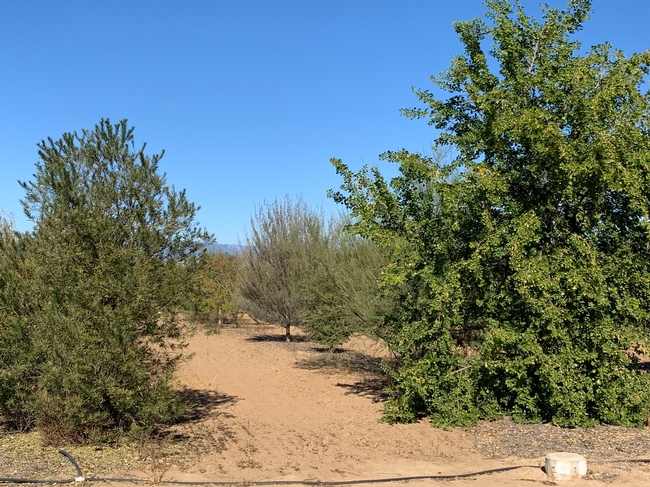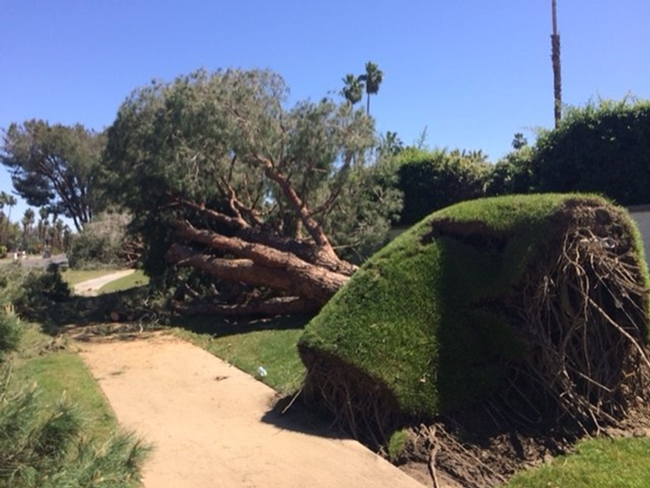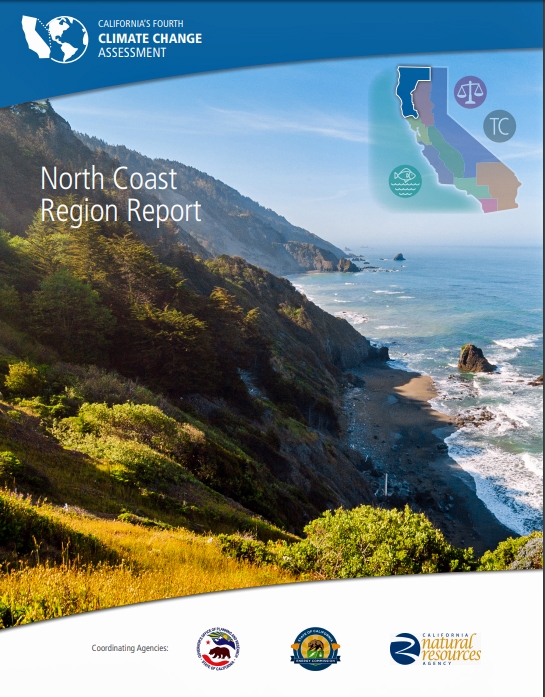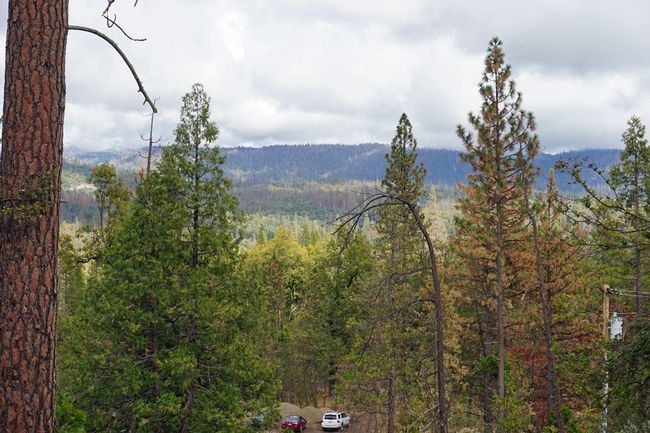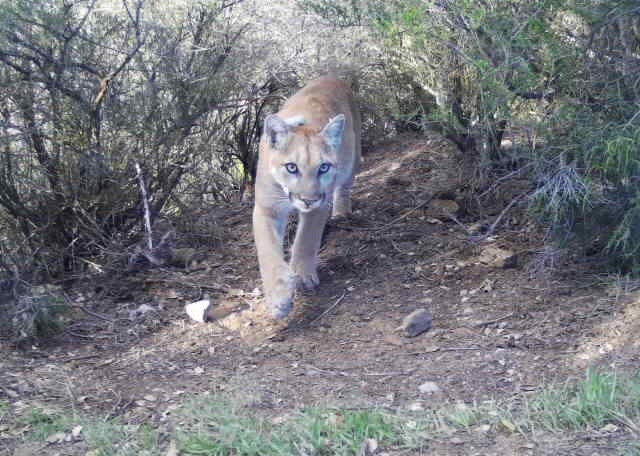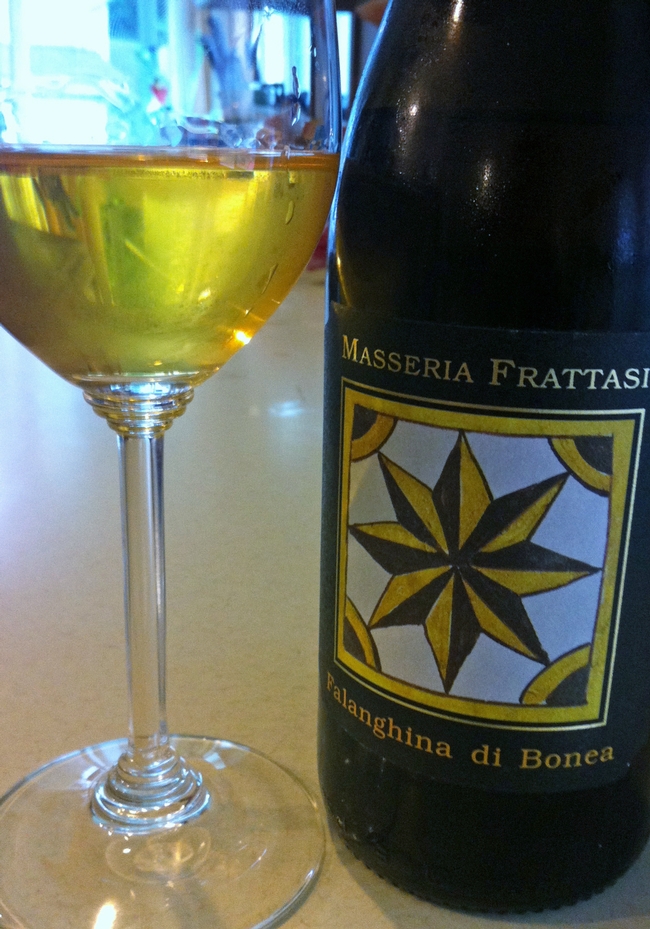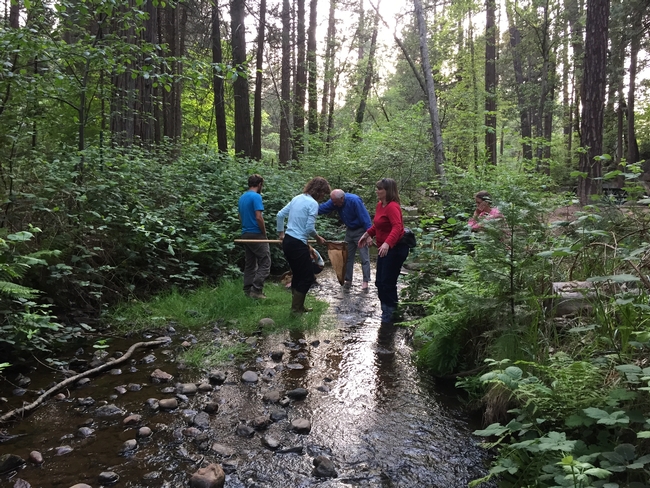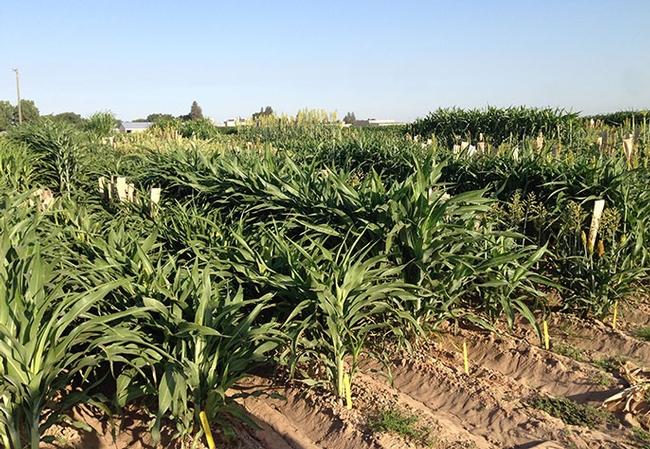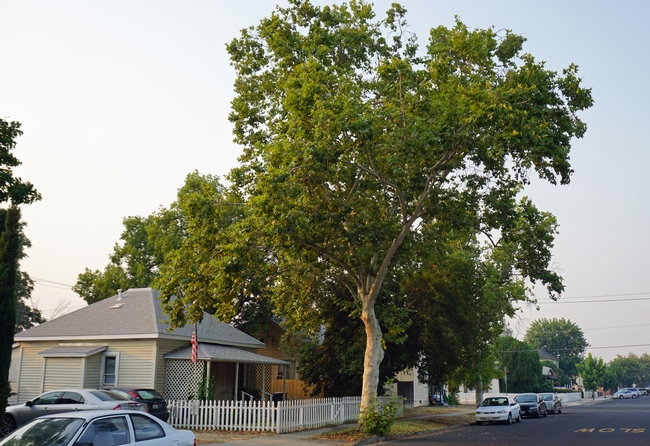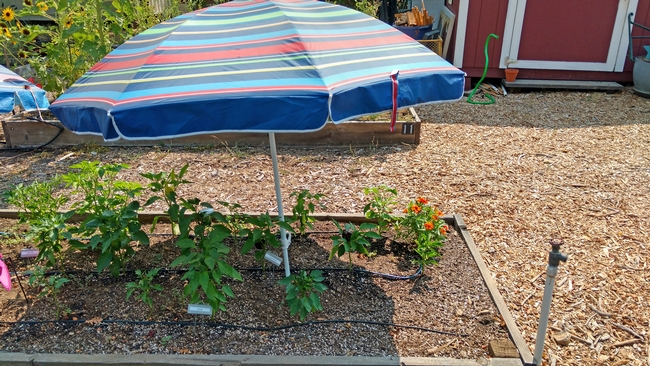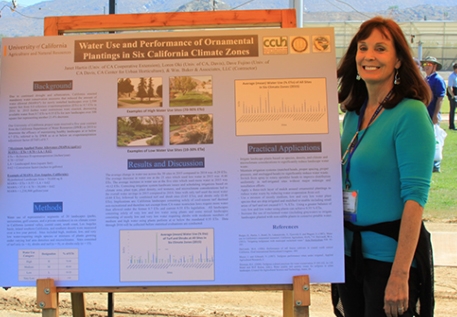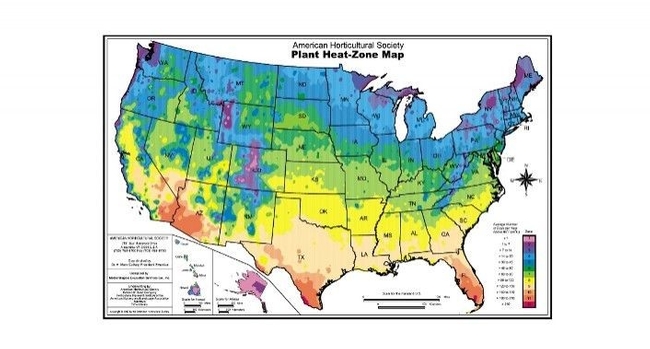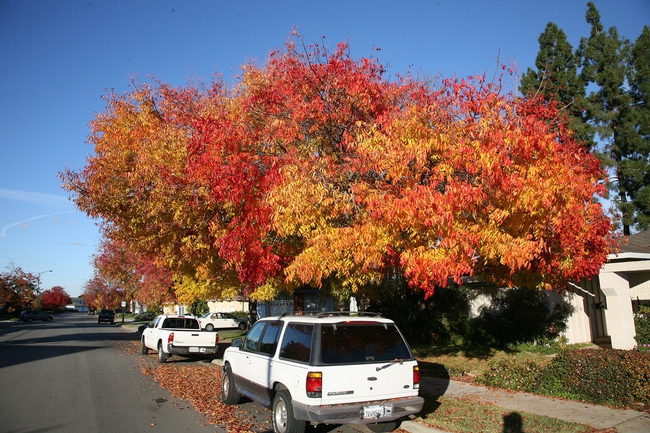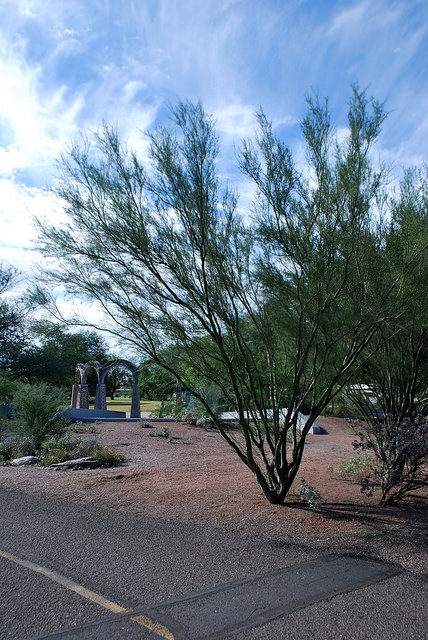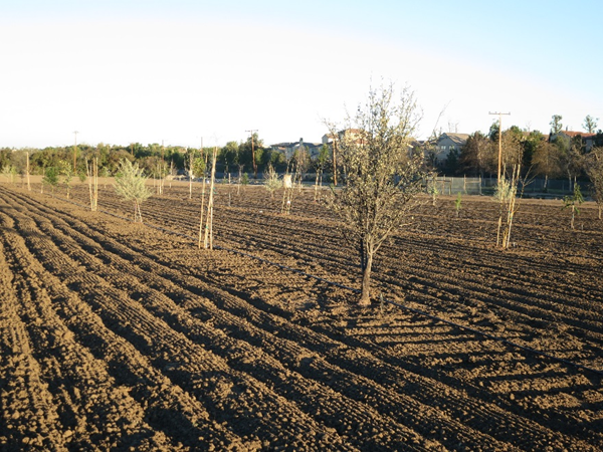Posts Tagged: Janet Hartin
The importance of trees to cool urban heat islands
Partnering for California
Spring 2021 proved to be one of the hottest in California, breaking heat records in several cities. It was a perfect opportunity to plant “climate-ready landscape trees” in inland cities identified in a study conducted by the University of California Cooperative Extension in partnership with the U.S. Forest Service.
The idea of bringing together community groups and volunteers to enhance tree canopies that cool urban heat islands --which can be more than 50 degrees hotter than surrounding areas -- in the Redlands area was spawned by Janet Hartin, UC Cooperative Extension environmental horticulture advisor for Riverside, San Bernardino and Los Angeles counties.
It became a reality when Mandy Parkes, district manager of Inland Empire Resource Conservation District, and Shelli Stockton of the University of Redlands received partner grants from the Climate Action Corps to start a nursery and get the “climate-ready landscape trees” in the ground. To date, nearly 100 trees from the study have been planted, including over 40 at the Redlands Sports Complex. As the volunteers in Redlands know, planting trees helps to cool these heat islands. After a long day of digging and planting in June, the volunteers were satisfied with their hard work and looked forward to sharing their experiences.
According to Parkes: “The project is moving along quickly due to excellent work of the Climate Action Fellows; inspiring research and support from Janet Hartin and the UC Cooperative Extension Master Gardeners who will ensure that residents continue to receive proper tree care help long after the planting ends; outreach by Mario Saucedo and his Redlands-based community action nonprofit organization, Common Vision Coalition.”
Saucedo, chairman of Common Vision Coalition, said, "It came together, all of us round-tabling on how we could do this pilot project and reach out to the community residents and offer them free trees for their homes."
Once the community accepted the project, the outreach began. James Berry of the California Climate Action Corps was excited after they got the green light from the city of Redlands to plant the trees.
"They are from two different species," said Berry. "The Western Bud and the Red Push Pistache. Both are heat tolerant and drought tolerant, making them ideal for the high temperatures we are facing, and the ones in the coming years as a result of the climate change."
“Our ‘Trees for Tomorrow' workshop we held last fall for city planners, wholesale and retail nursery personnel, landscape architects, landscapers, water districts community groups, and Master Gardeners resulted in pockets of multidisciplinary projects, tree planting projects across Southern California, including the Redlands project. The Redlands project exemplifies the core principles of a well thought out and executed project that includes long-term tree care, a real key to maximizing benefits of trees over their lifespans of 50 years and more.”
With a statewide drought forcing water restrictions, people are looking into options to save water. Hartin advises against sacrificing any trees.
"One of the things that I think is important to prioritize is to make sure that when we have to reduce our water use outside in urban areas, we maintain our trees as a top priority," said Hartin. "If that means for a year or two that our lawns and our flowering beds are going to go by the wayside, then that's just the situation."
She recommends something as simple as dragging a hose out and into the tree's drip line, making sure not to water the trunk, but the other side of the drip line where the active root system is.
"Climate-ready tree study: update for Southern California communities" by E. Gregory McPherson, Alison Berry, Natalie van Doorn, Janet Hartin, Jim Downer, Darren Haver and Erica Teach is published at https://www.fs.usda.gov/treesearch/pubs/60414.
To learn more about the study or how to combat climate change with trees:
“Trees for tomorrow start today.”
“Lush urban forest can help communities face climate change.”
Lush urban forests can help communities face climate change
Urban trees are much more than lovely greenery and stately landscape features. Scientists believe trees are a key tool for combating climate change and living with warming temperatures in California.
UC Cooperative Extension is bringing together municipal and nonprofit organizations, homeowners associations, contractors, the green industry and educators to increase the tree canopy in urban areas by planting recommended species. Nearly 200 people gathered online in March 2021 to share research results, accomplishments and tree canopy growth strategies at the “Trees for Tomorrow Start Today” workshop.
“We need to act now and together to build community forests,” said Janet Hartin, UCCE area environmental horticulture advisor in Southern California and the event organizer. “This is the time to talk about challenges and opportunities for a healthier tomorrow. As our cities grow, so do associated urban heat islands like asphalt-covered parking lots and streets.”
For decades, temperatures have been rising across the planet. While governments work worldwide to reduce carbon dioxide and other emissions that contribute to the greenhouse gases warming the earth, trees are a particularly effective way to make a significant impact on the problem at the local level.
“With proper placement around homes, trees can reduce home energy cost by 30 to 50 percent,” Hartin said. “Treeless urban parking lots can be 20 to 25 degrees hotter than park-like settings in the same area.”
Trees have myriad additional benefits. They provide cooling shade to sidewalks, schools and shopping centers. Trees remove dust from the air, create windbreaks, capture runoff, reduce glare, muffle urban noise and provide a habitat for birds and other animals. In the process of photosynthesis, trees also absorb and store carbon dioxide, helping reduce greenhouse gas emissions to the atmosphere.
With so many reasons to plant and maintain trees in urban communities, and with the overarching threat of climate change, there's no time to waste in nurturing lush green canopies in California cities, schools, parks and neighborhoods. Hartin said ensuring the proper tree selection, placement and care is critical.
“Trees improperly selected or not properly cared for are taking precious time away from the future benefit of trees,” she said.
UC conducts long-term research to identify the best urban trees
Hartin is working with a team of UC Agriculture and Natural Resources and U.S. Forest Service scientists to identify the best drought- and heat-tolerant trees for different areas of the state. Six years ago, the team vetted 100 trees native to California, the Southwest and Australia, taking into account habitat, physiology and biological interactions. A selection of fast-growing, drought-, heat- and pest-resistant species were planted at UC Riverside, the UC South Coast Research and Extension Center in Irvine and in Northern California to be evaluated over 20 years. In addition, Hartin has a subset of trees in a ‘mulch, no mulch' study at Chino Basin Water District in Montclair.
“We're beginning to see the best performers in those areas,” said Hartin, who shared a few of the tree species that have already caught her fancy.
Island Oak (Quercus tomentella) – A disease-resistant evergreen California native adapted to many Sunset magazine zones and soils.
Netleaf Hackberry (Celtis laevigata var. reticulate) – A deciduous tree with small red berries that attract birds. “This is performing beyond our expectations,” she said.
Thornless Honey Mesquite – (Prosopis glandulosa ‘Maverick') – Native to the Southwest U.S., the tree is heat tolerant and cold hardy. It grows as wide as it is tall – about 35 feet.
Pistacia ‘Red Push' (Hybrid of Pistacia atlantica × Pistacia integerrima) – Developed in Arizona, the tree grows 20-feet tall. “The foliage makes you think of Maine or Minnesota in the fall, but this tree has a brilliant red tinge when it first leafs out in the spring,” she said. “It's performing really well in our studies.”
Bubba Desert Willow (Chilopsis lineraris ‘Bubba') – “My favorite tree from our study,” Hartin said. “It grows fast, has beautiful trumpet-like flowers and requires little maintenance.”
Hartin recommends finding more details about these and other trees at http://selectree.calpoly.edu. Read more about the project here: UC study seeks street trees that can cope with climate change.
UC Master Gardeners provide advice on tree selection and maintenance
Proper location based on climate zone and specific conditions around one's home, planting and maintenance are important for tree longevity. Helpful information and support is available throughout California from UC Master Gardener Program volunteers.
Mandy Parkes of the Inland Empire Resource Conservation District said Master Gardeners are a “pivot point” for successful tree planting. She spearheaded a tree planting program in North Redlands that involves partnerships with the California Climate Action Corps, the city, ESRI, University of Redlands and UCCE to encourage residents to plant trees where the urban canopy is currently low.
“New tree owners need long-term support to aid selection and placement of trees,” Parkes said. “Master Gardeners can weigh in on yard design, irrigation and most importantly, guiding trees into the ground and caring for them correctly and in a way that works for the residents.”
Studies have shown that there is often less tree canopy cover in lower-income communities. In many under-served neighborhoods, canopy cover ranges from 0 to 11%, Hartin said, far short of the recommended 25% canopy cover.
“In wealthier neighborhoods, there tends to be higher canopy cover, and in addition, in those areas there is less asthma and cardiovascular disease,” Hartin said. “Encouraging planting in low-income neighborhoods is one of our goals.”
Andy Lyons, program coordinator for UC ANR's Informatics and GIS Statewide Program and a workshop participant said, “GIS technology and data offer exciting new possibilities for managing our urban trees, including the ability to create highly accurate maps of urban trees from aerial imagery, mobile data collection apps to monitor tree health, and the ability to overlay climate change projections for species selection and planning."
Threats to urban trees
Threats to trees were also discussed at the day-long Trees for Tomorrow meeting. West Coast Arborists' Cris Falco said he is frequently dismayed to see poorly pruned trees. “In my opinion, poor tree work is still the rule, not the exception,” he said.
A common mistake is cutting back, or heading, branches, while the goal should be a natural system of pruning to retain and promote characteristic growth. But, with 90% of the urban forest grown on private property, all too often poor tree architecture or inferior branch structure can lead to early tree failure. Falco and other speakers recommended regular pruning by a certified arborist.
Insect pests and diseases can also get in the way of long-term tree survival. Dave Rogers is a recently retired city arborist and currently acting director of the Community Services Department in Claremont, a college town in eastern Los Angeles County known as the “City of Trees and Ph.D.s.” He said the polyphagous shot hole borer reached Claremont and threated to kill heritage oaks and sycamores. Rogers gathered information and shared it with the city council, who provided $300,000 to treat infested trees. “The treatments worked,” he said.
But the pest continues to threaten trees in Los Angeles and Orange counties. One of the promising trees in the Trees for Tomorrow climate study, the Thornless Desert Museum Palo Verde, was found to be susceptible to shot hole borer, so experts are not recommending residents plant this tree.
Another pest, the ash borer, is in Eastern Texas and Boise Idaho, and will likely make its way to the West Coast eventually, said plantsman and workshop participant Nicholas Staddon of Everde Growers.
“It will kill every single ash tree we have,” said Staddon, who was a plant specialist at Monrovia Wholesale Nursery for many years. “We have to look at a broader diversity of trees. From the growers' perspective, trees are the most expensive items we grow. People who want to buy trees need to have some financial skin in the game for growing them.”
Making trees that are climate-tolerant but less common available to the public at nurseries is another hurdle. Nurseries carry what people are asking for, but people don't always know about tested species and even older, “tried and true” varieties.
“We have a list of trees adapted to the climate that are water wise, but at this point, it is difficult to find those in the nurseries,” said Debby Figoni, UC Master Gardener and water administrator for City of Beverly Hills. “It's one thing to know what you're supposed to plant. It's another to find that tree. We have to give people resources.”
The rich discussion regarding the need to enhance tree canopies with recommended species and proper long-term care did not end at the conclusion of the workshop, Hartin said.
“A goal of the workshop was to identify ways to work together more effectively across professions,” she said. “Lots of great ideas came out of the roundtable discussions that we'll be following up on. These include providing education on proper tree selection and care through local task forces consisting of members of the nursery and landscape industry and regular communication between these groups.”
UC Cooperative Extension works in local communities to help Californians adapt to climate change
Californians received bleak news last month when the state released its fourth assessment of climate change in California. The report predicts severe wildfires, more frequent and longer droughts, rising sea levels, increased flooding, coastal erosion and extreme heat.
“It's great to be living in a state where science and facts around climate change are valued,” said UC Cooperative Extension specialist Adina Merenlender, “but the recent forecasts may make you want to devour a quart of ice cream in a pool of salty tears.”
Modern civilization has changed the world climate, and even dramatic reductions in global greenhouse gas emissions at this point won't turn back the clock. The warming now predicted by Cal-Adapt is likely already “baked in,” even with our best mitigation efforts, said Igor Lacan, UC Cooperative Extension advisor in the Bay Area of California.
California has been a leader in facing the future climate head on. The state's first comprehensive assessment on climate change was produced in 2006 under then-Gov. Arnold Schwarzenegger. The second assessment, released in 2009, concluded that adaptation could reduce economic impacts of loss and damage from a changing climate. The third assessment was shaped by a request for more information on the adaptation options in the 2009 report. The fourth assessment was the first effort to break down global climate predictions and their impacts onto specific regions of California.
Author of the North Coast Region Report of the Fourth Assessment, Ted Grantham, praised state leaders for pushing forward efforts to slow climate change and adapt to the new weather conditions expected in California.
“California is playing a unique role in filling the void of leadership on this issue that the federal government was beginning to address under the Obama administration,” Grantham, a UC Cooperative Extension specialist based at UC Berkeley, said.
Across California, UC Cooperative Extension specialists and advisors are working in their local communities to prepare for warming temperatures and adapt to the changing climate. Following are examples of the efforts now underway.
Managing forests to survive the future
Among the suggested adaptation strategies in the 81-page North Coast Region Report, written by Grantham and his colleagues, the authors encourage government agencies and private forest owners to use prescribed fires and active forest management to reduce an overgrowth of trees and shrubs that fuel the more frequent and intense fires expected in the future.
Although climate change will create conditions conducive to catastrophic wildfire, the reason for dangerous forest overgrowth is related to decades of fire suppression on the landscape.
“Our forests are much denser and have more fuel buildup than they would have under a natural fire regime,” Grantham said. “Mechanical thinning, removing wood from the landscape and prescribed fires can help limit the impacts of wildfire.”
Native American tribes are being tapped to share their traditional ecological knowledge to inform this practice.
“Native Americans have used fire since time immemorial to manage their landscapes,” Grantham said.
Connecting habitats to allow species movement
When climate changes, plant and animal species may find their current habitats no longer fit the environment where they evolved. The fourth assessment technical report, Climate-wise Landscape Connectivity: Why, How and What Next, written by UCCE specialist Adina Merenlender, documented potential techniques to erase barriers to plant and animal movement.
“When we talk about wildlife corridors today, we might view a road as a barrier,” Merenlender said. “With climate change, the movement is over a much longer range for species to find suitable habitat at the end of the century.”
The report says research is needed to compare different approaches to designing climate-wise connectivity, determining how wide corridors need to be, and quantifying the impact of natural and anthropogenic barriers on possible range shifts.
California's wine industry is based on international varieties that come from Northern France, where the climate is cool, mild and consistent.
“They really require a cool to warm climate, not a hot climate,” said Glenn McGourty, UCCE viticulture advisor in Mendocino County.
There are many wine grape cultivars from Southern Europe – areas in Italy, Portugal and Spain – that are adapted to heat and make quality wines, but aren't well known. The varieties include Monepulciano, Sagrantino, Periquita and Graciano.
McGourty is studying how these cultivars perform in the warm interior of Mendocino County at the UC Hopland Research and Extension Center.
“We have many options as climates warm in the interior part of California to make wine that needs less amelioration in the winery compared to cultivars from Northern France,” McGourty said.
Recruiting and training climate stewards
The UC California Naturalist Program is moving full steam ahead with a new Climate Stewards Initiative to build engaged communities and functioning ecosystems that are resilient to changing climates.
California Naturalist, with trained volunteers across the state working with myriad conservation organizations, will be using its educational network to improve the public's understanding of climate change and engage the public in community action and local conservation.
“Climate stewards will offer in-person communication with your neighbors, tapping into science,” Merenlender said. “Improving climate literacy is an important outcome, but that won't happen through a website.”
Helping growers modify farming practices due to changing climate
USDA Climate Hub has awarded a grant to UC Cooperative Extension to support tools to assist growers in making strategic decisions in season and long term.
“We have many credible sources of weather and climate data, but often times we are challenged with translating it into decision support tools tailored to growers' needs,” said Tapan Pathak, UCCE specialist in climate change adaptation in agriculture. “It's too early to say which specific tools we will develop, but we are aiming to help farmers use weather and climate information in decision making processes.”
Pathak is also working with colleagues to analyze how generations of navel orangeworm, a significant almond pest, might shift for the entire Central Valley under climate change and how growers can adapt their practices to manage the higher pest pressure.
Using epigenetics to impart drought tolerance
At the UC Kearney Agricultural Research and Extension Center in Parlier and the UC West Side Research and Extension Center in Five Points, sorghum nurseries are being grown under drought and well-watered conditions to compare the environmental impacts on the plants' gene expression.
“We hope to tease out the genetics of drought tolerance in sorghum,” said Jeff Dahlberg, UCCE specialist, who is managing the trials at Kearney. “Using sorghum as a model, we expect this research to help us understand drought tolerance in other crops as well.”
Historically, the genetic manipulation of crops, which has been critical to increasing agricultural productivity, has concentrated on altering the plant's genetic sequence, encoded in its DNA.
Recent studies have shown that environmental stresses – such as drought – can lead to epigenetic changes in a plant's genetic information. Because epigenetic changes occur without altering the underlying DNA sequence, they allow plants to respond to a changing environment more quickly.
Cities can plant street tree species suited to future climate
Many common street trees now growing in the interior of California are unlikely to persist in the warmer climate expected in 2099, according to research published in the July 2018 issue of the journal Urban Forestry & Urban Greening. (Read the research report here until Sept. 27, 2018)
“Urban foresters in inland cities of California should begin reconsidering their palettes of common street trees to prepare for warmer conditions expected in 2099 due to climate change,” said the study's co-author, Igor Lacan, UC Cooperative Extension environmental horticulture advisor in the Bay Area.
Common trees in Coastal California cities appear to be better suited to withstand the 2099 climate.
“Our research shows that some trees now lining the streets of cities like Fresno, Stockton and Ukiah are likely to perform poorly in 2099,” Lacan said. “Those cities need to look at the conditions – and trees – now found in El Centro, Barstow and Fresno respectively.”
Trees to shade California in a warmer future
The changing climate predicted for California – including less rain and higher day and nighttime temperatures – is expected to cause chronic stress on many street tree species that have shaded and beautified urban areas for decades.
Realizing that popular trees may not thrive under the changing conditions, UC Cooperative Extension scientists are partnering with the U.S. Forest Service in a 20-year research study to expand the palette of drought-adapted, climate-ready trees for several of the state's climate zones.
“The idea is to look at available but under-planted, drought-tolerant, structurally sound, pest resistant trees for Southern California that do well in even warmer climates,” said Janet Hartin, UCCE horticulture advisor in San Bernardino County.
Twelve tree species were selected for each climate zone in the comparative study, with several area parks used as control sites.
Managing the forest for survival in warmer conditions
UC Cooperative Extension scientists are part of a collaborative research project with the University of Nevada, Reno, CAL FIRE and the U.S. Forest Service aimed at developing new strategies to adapt future forests to a range of possible climate change scenarios in the Sierra Nevada.
“It includes the idea that we may be struggling just to keep forests as forests, let alone having the species we value,” said Rob York, manager of UC Berkeley's Blodgett Forest Research Station near Georgetown.
Forests sequester a tremendous amount of carbon. As the climate changes, foresters will need to be proactive to reduce the risk of these massive carbon sinks becoming carbon sources.
“We're working to mitigate predicted impacts to forests, including regeneration failures, drought mortality and catastrophic wildfire,” Ricky Satomi, UCCE natural resources advisor in Shasta County.
At three separate study sites across the Sierra Nevada, novel approaches to forest management are being implemented to develop treatments that scientists believe will increase resilience, resistance and adaptability of Sierra Nevada mixed conifer forests.
The 2018-21 project is led by Sarah Bisbing, forest ecology professor at the University of Nevada, Reno, and funded with $2.7 million from CAL FIRE.
Climate change impacts on vulnerable communities
The latest climate assessment also reports on the serious nature of climate threats to vulnerable communities and tribal communities in California, with a focus on working collaboratively with these communities on research and solutions for resilience.
“The impacts of climate change will not be experienced equally among the population,” Grantham said. “The most significant public health and economic impacts – from flooding, extreme heat, air quality degradation, etc. – will be disproportionately experienced by vulnerable populations, including people of color, the poor and the elderly.”
The assessment includes a Climate Justice Report, which shares the idea that no group of people should disproportionately bear the burden of climate impacts or the costs of mitigation and adaptation. The report suggests collaborating with these communities on research and solutions for resilience.
Protect your garden when temperatures soar
When unusually hot weather is in the forecast, it's time irrigate, shade and mulch plants to protect your plants, reported Sandra Barrera in the Los Angeles Daily News.
The story was prompted by a heat spike in Southern California recently, when temperatures soared above 110 degrees in many areas.
"While most plants can endure triple-digit temperatures, they suffer when heat comes on suddenly," the article said.
- When a plant is dry, it's already stressed, so give it a good soaking before temperatures rise.
- A patio umbrella, bed sheets or landscape shade cloth suspended on the sunny side of a plant will shade tender growth on hot days.
- A three- to four-inch layer of mulch around plants will cool roots and hold moisture.
One of the best ways to avoid heat damaged trees and plants is by planning a garden for the climate.
"In Southern California, Sunset zones are preferred over USDA zones due to their greater accuracy," said Janet Hartin, UC Cooperative Extension environmental horticulture advisor for San Bernardino, Riverside and Los Angeles counties.
Hartin suggests consulting the California Native Plant Society's Calscape and Cal Poly San Luis Obispo's SelecTree for information on plants adapted to the climate and specific conditions, such as sun, shade, near buildings or swimming pools or in urban heat islands.
The American Horticultural Society also has a Heat Zone Map to select plants adaptable to inland and desert climates. The map has 12 zones searchable by city. Each zone designates the average number of days per year temperatures exceed 86 degrees, which is considered by the point at which most plants begin to suffer heat stress.
"The numbers are relatively conservative and many plant enthusiast experimenters are already finding that many plants - under the right conditions and a little shade - do just fine outside of their listed heat zone," Hartin said.
UC study seeks street trees that can cope with climate change
The changing climate predicted for California – including less rain and higher day and nighttime temperatures – is expected to cause chronic stress on many street tree species that have shaded and beautified urban areas for decades.
Realizing that popular trees may not thrive under the changing conditions, UC Cooperative Extension scientists are partnering with the U.S. Forest Service in an unprecedented 20-year research study to expand the palette of drought-adapted, climate-ready trees for several of the state's climate zones.
“The idea is to look at available but under-planted, drought-tolerant, structurally sound, pest resistant trees for Southern California that do well in even warmer climates,” said Janet Hartin, UCCE horticulture advisor in San Bernardino County.
Hartin, a 34-year veteran advisor, said the project is her first to stretch to 20 years; it will likely extend past her tenure with UCCE.
“I'd like to retire in five or six years,” she said. “But I'm very excited about being a pioneer in a study that will continue with my successors. I think it's important for our children and our children's children, as well as for the environment.”
At the end of 2019, with three years of data on tree health and growth rates, the scientists expect to be able to publish the first results and make them available to arborists, urban foresters and residents throughout the regions of the study.
Twelve tree species were selected for each climate zone in the comparative study, with several area parks used as control sites. Hartin and her Southern California research collaborators – UCCE advisors Darren Haver of Orange County and Jim Downer of Ventura County – worked closely with UC Davis plant biologist Alison Berry, UC Davis research associate Greg McPherson and USFS research urban ecologist Natalie van Doorn to select promising species.
They looked for trees that are already available at local nurseries, but are underutilized. The trees in the project exhibit drought tolerance and disease resistance, plus produce minimal litter. The researchers also sought trees that would provide ample cooling shade for a long time – ideally 50 years or longer.
The varieties come from areas around the world with climates similar to California. Two trees planted in replicated plots at the UC Riverside Citrus Field Station are native to Australia, two are native to Oklahoma and Texas, one is native to Asia and two are non-native crosses of other trees. Three of the trees are native to California: the netleaf hackberry, Catalina cherry and island oak.
“Trees are a long-term investment,” Hartin said. “A tree will live 50, 70, 90 years. The proper selection is very important to help ensure longevity.”
Making the long-term investment with the proper selection yields considerable returns. In a warming world, trees are natural air conditioners.
“Urban areas create heat islands, with dark asphalt surfaces reradiating heat. Cities can be 10 to 20 degrees warmer than the surrounding environment,” Hartin said.
Other tree benefits include soil health and stability, wildlife habitat and aesthetic beauty.
Following are a sampling of trees that are part of the comparative study:
Acacia – A 20-foot-tall, 20-foot wide evergreen that is drought resistant, and withstands moderate irrigation. Native of Australia.
Blue palo verde – A tree that reaches about 25 feet in height, the Blue palo verde is drought resistance and lives 50 to 150 years. Its trunk, branches and leaves have a blue-green hue. Native to the southwestern U.S. and Mexico.
Brazilian cedarwood – A native of Brazil and Paraguay, the deciduous tree grows to 50 to 65 feet. The tree produces pale yellow tubular flowers in the spring.
Catalina cherry – Native to the chaparral areas of coastal California, the Catalina cherry grows to 30 feet high. The evergreen tree tolerates drought when mature. It produces sweet purple-to-black edible fruit.
Chinese pistache – A deciduous tree with beautiful fall color. Grows to 35 feet tall, 30 feet wide. Drought resistant, but tolerates moist soil. Native to central and western China.
Desert willow – Growing to 30 feet tall and living 40 to 150 years, the desert willow tolerates highly alkaline soil and some salinity. A deciduous tree, it boasts large pink flowers all summer that attract hummingbirds and other wildlife. Native to the southwestern U.S. and northern Mexico.
Escarpment live oak – Native to west Texas, this tree is cold hardy and drought tolerant. Typically evergreen, it can be deciduous in colder climates.
Ghost gum – Very tall at maturity and drought tolerant. An Australia native.
Indian laurel – Commonly called a ficus, this is a 35-foot-tall, 35-foot-wide tree at maturity that is drought resistant and tolerates highly alkaline and saline soils. Shade potential is high. Native of Asia and Hawaii.
Ironwood – A southwestern and northern Mexico native, Ironwood is semi-drought resistant once mature and tolerates alkaline soil. Ironwood, which grows to about 33 feet tall, can live 50 to 150 years.
Island oak – This tree is native to five of six California off-shore islands. Drought tolerant, it grows to nearly 70 feet tall when mature.
Maverick mesquite – Native to the southwestern U.S. and northern Mexico, this tree does well in full sun and is drought resistant once established. The tree grows to 35 feet tall. The Maverick mesquite is a thornless variety.
Mulga – A versatile and hardy tree that grows 15 to 20 feet in height, the mulga – a Western Australia native – tolerates hot and dry conditions. The leaves are evergreen and the tree has yellow elongated fluffy flowers in spring.
Netleaf hackberry – A California native, the netleaf hackberry grows to 30 feet. Its deep root systems and heat resistance makes the tree idea for urban conditions.
Rosewood – Native to southern Iran, Indian rosewood grows to 65 feet tall, and 40 feet wide. Evergreen. Semi drought resistant and intolerant of alkaline soil.
Shoestring Acacia – Evergreen and 30 feet tall when mature, shoestring acacia is drought resistant and thrives in slightly acidic to highly alkaline soils. Native to Australia.
Tecate cypress – A native of Southern California and Mexico, the Tecate cypress is very drought tolerant. Its foliage is bright green. Young trees are pyramidal in shape, becoming more rounded or contorted with age.
Partners in the tree study are Los Angeles Beautification Team volunteers, LA Parks and Recreation team, Chino Basin Water Conservation District, and Mountain States Wholesale Nursery.
Funding and other support is provided by LA Center for Urban Natural Resources Sustainability, ISA Western Chapter, Britton Fund, USFS Pacific Southwest Research Station, and the UC system.


